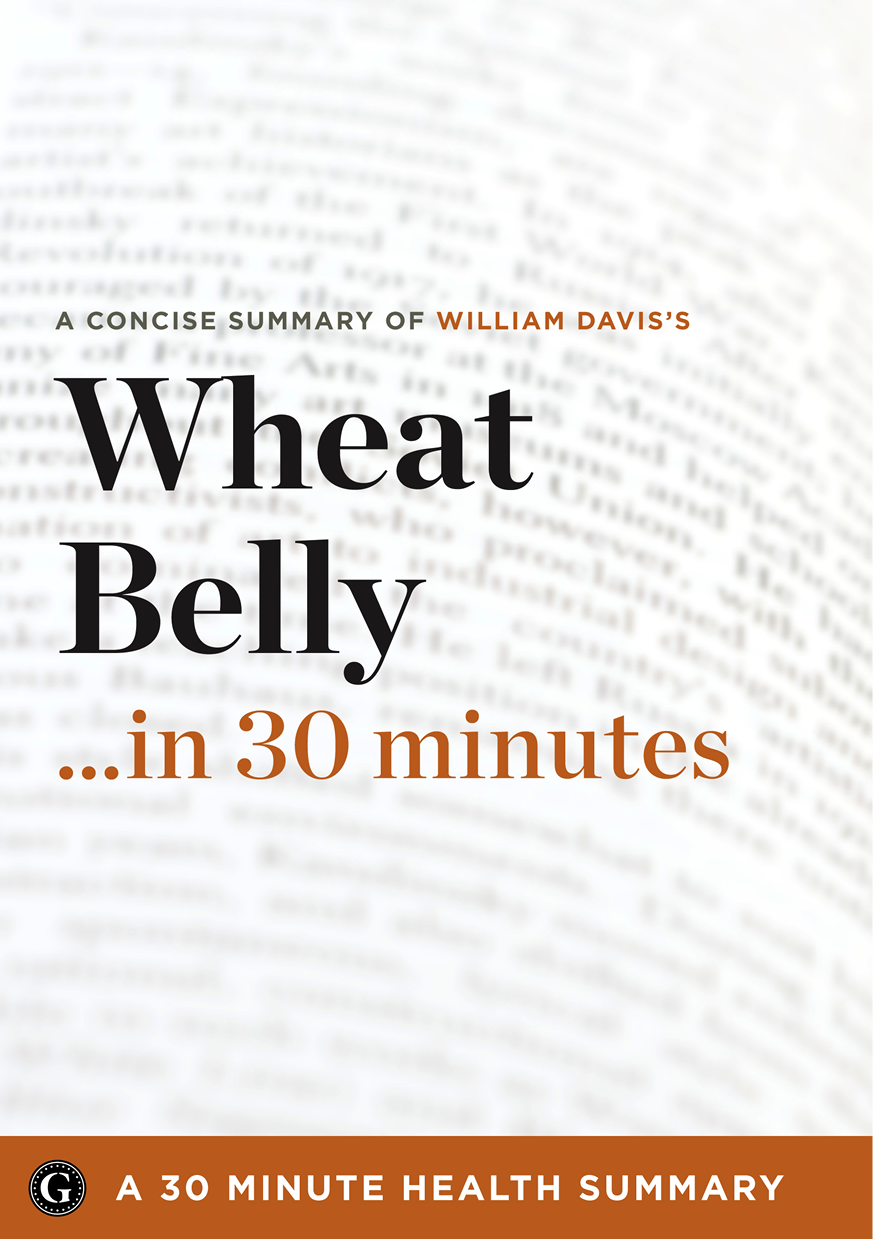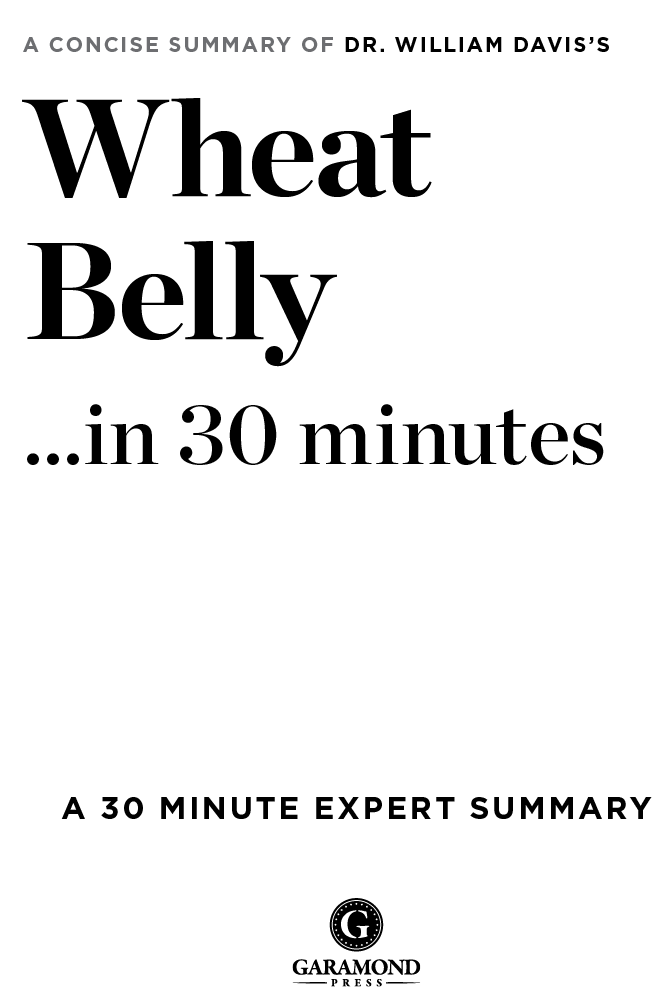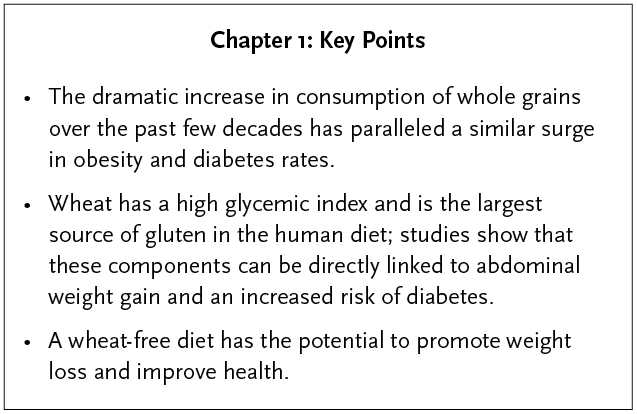Summary: Wheat Belly ...in 30 Minutes
Read Summary: Wheat Belly ...in 30 Minutes Online
Authors: 30 Minute Health Summaries


Copyright © 2012 by Garamond Press, Berkeley, California
No part of this publication may be reproduced, stored in a retrieval system or transmitted in any form or by any means, electronic, mechanical, photocopying, recording, scanning, or otherwise, except as permitted under Sections 107 or 108 of the 1976 United States Copyright Act, without the prior written permission of the Publisher. Requests to the Publisher for permission should be addressed to the Permissions Department, Garamond Press, 918 Parker St, Suite A-12, Berkeley, CA 94710.
Limit of Liability/Disclaimer of Warranty: The publisher and the author make no representations or warranties with respect to the accuracy or completeness of the contents of this work and specifically disclaim all warranties, including, without limitation, warranties of fitness for a particular purpose. No warranty may be created or extended by sales or promotional materials. The advice and strategies contained herein may not be suitable for every situation. This work is sold with the understanding that the publisher is not engaged in rendering medical, legal or other professional advice or services. If professional assistance is required, the services of a competent professional person should be sought. Neither the publisher nor the author shall be liable for damages arising herefrom. The fact that an individual, organization or Web site is referred to in this work as a citation and/or a potential source of further information does not mean that the author or the publisher endorses the information the individual, organization or Web site may provide or recommendations they/it may make. Further, readers should be aware that Internet Web sites listed in this work may have changed or disappeared between when this work was written and when it is read.
For general information on our other products and services or to obtain technical support, please contact our Customer Care Department within the U.S. at (866) 744-2665, or outside the U.S. at (510) 253-0500.
Garamond Press publishes its books in a variety of electronic and print formats. Some content that appears in print may not be available in electronic books, and vice versa.
UNOFFICIAL: This summary book is unofficial and unauthorized. This book is not authorized, approved, licensed or endorsed by Dr. William Davis or Rodale Books.
TRADEMARKS: Garamond Press and the Garamond Press logo are trademarks or registered trademarks of Callisto Media Inc. and/or its affiliates, in the United States and other countries, and may not be used without written permission. All other trademarks are the property of their respective owners. Garamond Press is not associated with any product or vendor mentioned in this book.
ISBNs:
978-1-62315-038-9 Print
978-1-62315-039-6 eBook
TABLE OF CONTENTS
Chapter Summaries
Chapter 2: Not Your Grandma's Muffins: The Creation of Modern Wheat
Chapter 3: Wheat Deconstructed
Chapter 4: Hey, Man, Wanna Buy Some Exorphins? The Addictive Properties of Wheat
Chapter 5: Your Wheat Belly Is Showing: The Wheat/Obesity Connection
Chapter 6: Hello, Intestine. It's Me, Wheat. Wheat and Celiac Disease
Chapter 7: Diabetes Nation: Wheat and Insulin Resistance
Chapter 8: Dropping Acid: Wheat as the Great pH Disrupter
Chapter 9: Cataracts, Wrinkles, and Dowager's Humps: Wheat and the Aging Process
Chapter 10: My Particles Are Bigger Than Yours: Wheat and Heart Disease
Chapter 11: It's All in Your Head: Wheat and the Brain
Chapter 12: Bagel Face: Wheat's Destructive Effect on the Skin
Chapter 13: Goodbye, Wheat: Create a Healthy, Delicious, Wheat-Free Life
INTRODUCTION
Overview
In
Wheat Belly,
Dr. William Davis makes the case that eliminating wheat will lead to a healthier life. Through personal experiences, clinical studies, and an exploration of the diseases and medical conditions associated with different diets, Davis details the damaging effects that modern, genetically manipulated wheat has had on the human body.
Since it was first introduced as einkorn wheat in its most ancient form, wheat has been genetically manipulated to create faster-yielding, higher-performing, better-tasting versions of itself. Davis suggests that through this process, wheat has also become incompatible with human digestion. Ironically, due to a shift in nutritional guidelines in the past fifty years, people are consuming wheat in unprecedented amounts, believing that whole grains are essential to a balanced diet. The results are dramatic. Davis explores wheat's adverse effects on the entire body, from the blood to the heart to the visceral organs to the skin, presenting a wheat-free diet as the ultimate solution. He promises that once wheat is eliminated, weight loss, better sleep, and overall better health will follow.
About the Author
William Davis, MD, is a cardiologist who uses a wheat-free approach not only to prevent but also to reverse heart disease in his patients. He is medical director and creator of the Track Your Plaque program, a program that outlines how to use CT heart scans to detect, track, and control coronary plaque. His previous book,
Track Your Plaque,
describes this program in detail. Davis is a consultant for the nutritional supplement industry and serves as vice president for cardiology for Obesity PPM, a consulting firm that offers solutions to the obesity crisis. He has been published in the
American Journal of Therapeutics
and
Life Extension Magazine,
and contributes frequently to health websites.
How the Book Came About
Dr. Davis first came to question the idea of a healthy diet high in whole grains when he noticed a photo of himself from a family vacation in Florida. While he jogged five miles a day and ate a sensible, balanced diet, in the photo he was clearly fat, at least thirty pounds overweight. When he made this discovery, Davis was in the midst of devising a unique strategy for helping his diabetic and prediabetic patients lose weight, one that lowered glucose (blood sugar) levels by eliminating wheat. Many of the patients dropped thirty to forty pounds, and they also reported improved energy, deeper sleep, and the disappearance of a variety of symptoms, ranging from abdominal cramping to rashes to asthma. Davis was intrigued. What began as a weight-loss strategy turned into a deeper exploration of wheat and its effects, mostly damaging, on the human body. In the
New York Times
best seller
Wheat Belly,
Davis describes what he uncovered.

WHAT
BELLY?
Overview
Mainstream dietary recommendations over the past few decades are to eat less fat and sugar and more whole grains. Yet Americans have increasingly become obese. Davis says this is because we consume foods that contain wheat products at nearly every meal. Studies show that wheat, which has a higher glycemic index (the measure of how much a particular food increases the blood sugar level) than refined sugar, is a direct cause of abdominal weight gain.
Wheat Belly
proposes that by eliminating wheat from their diet, people can reduce belly fat and become thinner, healthier, and more energetic. Signs of diabetes and inflammatory diseases such as arthritis and asthma may also be reduced or eliminated.

“Advice to cut fat and cholesterol intake and replace the calories with whole grains that was issued by the National Heart, Lung, and Blood Institute through its National Cholesterol Education Program in 1985 coincides precisely with the start of a sharp upward climb in body weight for men and women.”
â Dr. William Davis,
Wheat Belly

Chapter Summary
As dietary recommendations have created a national trend to cut back on fats and sugars and replace these with whole grains, there has been a marked increase in waistlines and a noticeable decline in overall health â even among people who exercise regularly. According to Davis, wheat has come to dominate Americans' diets, making people fat and unhealthy.
Whole wheat bread, with a glycemic index of 72, raises blood sugar levels more than sugar, with a glycemic index of 59. When blood sugar levels rise, more insulin is produced. Insulin is a hormone that, among other functions, tells the body to store fat.
Fat stored in the central part of the body, known as visceral fat, provokes inflammatory responses in the body (which can lead to diseases such as arthritis), disrupts the insulin response (which can lead to diabetes), and sends abnormal metabolic signals to the rest of the body (which can lead to overeating). This visceral fat, sometimes called a beer belly, Davis calls “wheat belly” because it represents the accumulation of fat that results from years of consuming wheat-related products.
According to Davis, the simple cure for wheat belly and its accompanying ailments is to eliminate wheat from the diet. Once wheat is gone, he says excess weight will melt away, energy and focus will improve, and even diseases such as diabetes may be lessened or cured.

“[F]or the most bang for your buck, eliminating wheat is the easiest and most effective step you can take to safeguard your health and trim your waistline.”
â Dr. William Davis,
Wheat Belly

